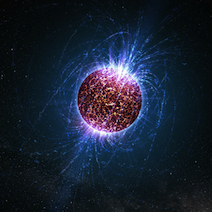Among all the objects in our Universe, a few of them are truly extraordinary, and sometimes not that easy to comprehend. Black holes, for example, are fascinating. But there are other objects which may exist, maybe not as popular the gravitational singularity, that are literally… strange.
Massive stars, after they explode into supernovae, don’t have a unique fate. While the most massive ones will eventually turn into a black hole, swallowing anything crossing their event horizon, others, less massive, will become neutron stars. Neutron stars – their name speaks for itself – are essentially made of neutrons. They are extremely hot and dense: the density of a neutron star would be equivalent to the entire human population squeezed down to the size of a sugar cube!
Could there be anything denser than this, that wouldn’t turn into a black hole? Could there be stars that are too massive to become neutron stars, but not enough to become black holes? The answer is yes, at least theoretically.
Something called neutron degeneracy pressure prevents neutron stars from collapsing under their own gravity: two neutrons cannot be in the same quantum state in the same place. In case this pressure cannot hold up against the star’s gravity, neutrons then break down into their constituents, called quarks, and then form a quark star.

Quarks are one of the fundamental constituent of matter, and they come in six “flavors”: up, down, top, bottom, charm and strange. They combine to form other particles, such as protons and neutrons, among others. Neutrons are made of up and down quarks; when neutrons break down, some of their quarks may become strange quarks and form strange matter. This is why quark stars are often called strange stars.
So far, no quark star has ever been detected, or confirmed. Indeed, a couple of overdense neutron stars have been observed and proposed as possible candidates: RX J1856.5-3754 and 3C58. However, there isn’t much supporting evidence.
What if we could push the limits even further?.. Some stars could theoretically reach even more extreme densities in their core: their density would be the same as that of the universe 10-10 seconds after the big bang! At that point, quarks inside the star are converted into pure energy and neutrinos, and the electromagnetic and weak nuclear forces become indistinguishable: radiation pressure resulting from this “electroweak burning” prevents the star from collapsing. Such stars are called electroweak stars, and they could live at least 10 million years, burning strange matter in their core.

While electroweak stars wouldn’t be much different from usual neutron stars on the outside, their core, which is about the size of an apple, would be the only place in the Universe where matter naturally goes back to its primordial state. In other words, at such an insane density, matter would be back to what it was a fraction of nanosecond after our Universe was born.
